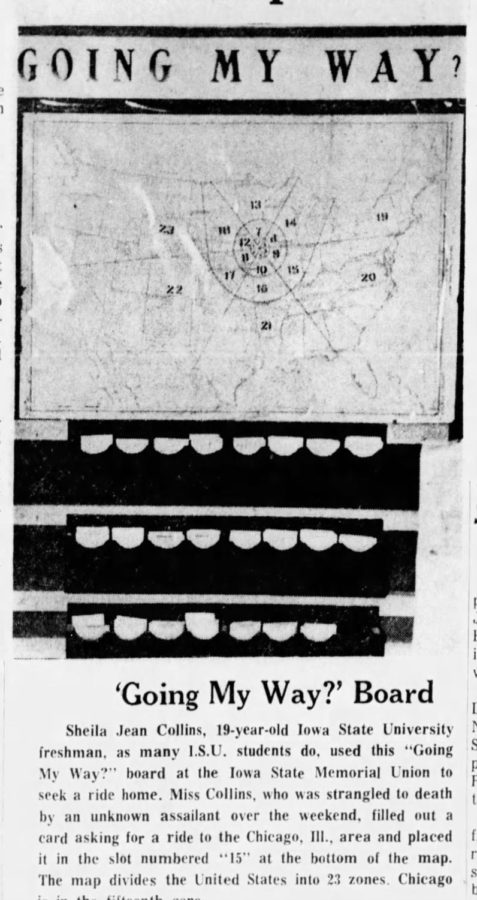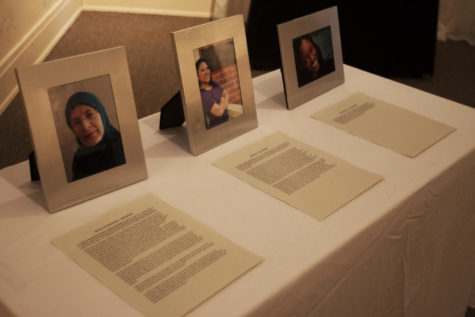Part four: Theories, but no arrests
January 28, 2022
Editor’s Note: This article is the fourth part in a five-part series telling the story of Sheila Jean Collins, an Iowa State student who was murdered in 1968. Part three can be read here.
Content Warning: This article contains mentions of sexual and physical assault.
Suspect No. 1: “Arthur”
In June 1968, authorities brought in one of the first strong suspects in Sheila’s death. “Arthur” emerged as a suspect after officers caught him calling women who had left their phone numbers at the ride-share board in the Memorial Union.
“[Arthur] was polygraphed back in ’68, and he showed signs of deception on using a fake name. There was something going around about that same time of guys calling females and wanting to meet up with them,” said Anthony Rhoad, the current investigations sergeant for the Story County Sheriff’s Office. “He was actually caught by Ames PD when they were doing some sort of sting operation where co-eds were being called on the phone using fake names.”
Arthur admitted to calling more than 30 female students using a false identity. He attempted to convince the young women to meet him on campus at night. One woman reported that he asked her to meet him on Lincoln Way, the same street where Sheila was picked up. According to a police report, he was sexually aggressive toward at least one female student. When these allegations were made, Arthur was married and the father of a young child.
Arthur, then a graduate student at Iowa State, lived near campus at the time of Sheila’s murder. He was a man of average height and build with short, brown hair. His appearance fit the description of the man witnesses saw picking up Sheila.
Detectives inquired about the car Arthur was driving in January 1968. Initially, he told them he was driving a yellow Mustang. However, he later admitted to borrowing a blue Volkswagen, which he was driving the month Sheila disappeared. He told detectives he purchased a new car on Feb. 5, 1968, claiming he had forgotten which car he was driving at the time of the death.
When investigators searched the trunk of Arthur’s new car, they discovered rope that matched the nylon cord used to strangle Sheila. He was not able to explain why he had it.
A year after Sheila’s death, another woman was killed in a homicide in Burlington, Iowa. Dorothy Miller, a real estate agent, was contacted by a young man who asked her to show a house at night. During the showing, she was struck on the head, tied up, raped and stabbed. The killer left her naked from the waist down with her dress and bra pushed up around her neck.
Investigators speculated that the killing might be linked to Arthur.
The killer used a fake name and said he was from Des Moines, Iowa, where Arthur was living at the time. Like Arthur, the man said he was married and had a young child. Witnesses described the killer as a young man of average height and build with short, brown hair. Miller’s husband, who had seen the killer, helped investigators create a composite sketch of the suspect. Arthur strongly resembled the man in the drawing.
Despite being a person of interest in two homicides, Arthur was never charged with either crime.
Investigators questioned his guilt in Sheila’s murder because of his spotless record and lack of a criminal history. In addition, a polygraph exam did not find signs of deception when he claimed to have no knowledge of Sheila’s death.
Polygraph tests were prevalent in criminal investigations decades ago, but research suggests their validity is questionable. According to the American Psychological Association, “There is no evidence that any pattern of physiological reactions is unique to deception. An honest person may be nervous when answering truthfully and a dishonest person may be non-anxious.”
Today, Arthur still lives in the Midwest and works as a business executive. Public records reveal no evidence of a criminal history.
Suspect No. 2: Gary Leiterman
Another primary suspect in Sheila’s murder had a glaring criminal record. Gary Leiterman was convicted of killing a woman named Jane Mixer in Michigan in 1969. Mixer’s and Sheila’s murders shared several similarities, which led authorities to question whether there was a connection in their deaths.
Like Sheila, Mixer left her name on a ride-share board at her college, hoping to catch a ride home. She never made it there. Her body was found in a rural area, covered by her coat. Her other belongings were displayed near the body, similar to Sheila’s. Mixer was also strangled to death, and Leiterman shot her twice in the head afterward.
In 1968, Leiterman was 26 and working as a traveling pharmaceutical salesman in the upper Midwest. He had an average build and short brown hair. According to his 1969 roommate, he was obsessed with the Michigan murders committed by John Norman Collins in the mid-1960s.
The similarities between Mixer’s and Sheila’s murders were suspicious, but investigators never found enough evidence to link Leiterman to Sheila’s death.
In 2019, Leiterman died in prison at the age of 74.
Suspect No. 3: “Clarence”
In 2004, decades after Sheila’s death, one man even confessed to killing her.
“Clarence” was the same height and build that witnesses described. At the time of the murder, he was living with his uncle in Minnesota. He would have been 17.
“The problem was, he didn’t live in the state at the time, had no connections to Iowa State,” Rhoad said.
The details Clarence provided in his confession did not match what investigators knew about the case. He claimed to have been arrested in Minnesota. He told officers he stabbed Sheila and disposed of her body in a river. He even referred to Sheila as “Cindy Collins.”
“Nothing that he said really matched up,” Rhoad said.
While Clarence remains on the suspect list today, Rhoad does not believe he killed Sheila. Clarence suffered from a severe mental illness that Rhoad believes drove him to confess to a crime he did not commit.
Suspect No. 4: “Bernard”
“Bernard,” the last suspect in Sheila’s case, seemed to be a likely culprit given his criminal history and a series of suspicious circumstances that followed the murder.
Bernard was a tall, lanky man with reddish-blond hair who worked as a graduate student lab technician at Iowa State. He was known to be “‘difficult,’ highly-sexed, suspicious, easily angered, controlling and a perfectionist,” according to an investigator’s report.
Bernard joined the army in the early 1960s but was dishonorably discharged for being AWOL and “unfit.” A chronic liar with an exaggerated sense of importance, he invented “facts” in his biography, according to investigators. He married three times throughout his life and had one son.
“He was kind of the creepiest out of all of them,” Rhoad said.
Bernard came to investigators’ attention in 1968 when one of his co-workers sent an anonymous note to the Story County attorney. The note said Bernard — who was disliked at work because of his abrasive personality and paranoia — drove a blue Volkswagen and had scratches on his face after Sheila’s murder.
Adding to suspicions, on the night Sheila disappeared, Bernard called his wife at 10 p.m. to let her know he would not be able to pick her up from work because he had a flat tire. He later said he had fallen while changing the tire, which is how he received the scratches on his face. His wife said he returned home without his eyeglasses, which he said he lost in the fall.
Yet the timeline that investigators had pieced together about Sheila’s death made it difficult to see how Bernard could have committed the crime. His flat tire occurred on North Dakota Avenue in northwest Ames. That meant he would have had to pick up Sheila on campus about 8:30 p.m., drive about 15 miles, kill her and dispose of her body and belongings, then drive about 21 miles back to northwest Ames, flatten his tire and call his wife — all by 10 p.m. Additionally, his wife told investigators there is no way he could have driven that far without his glasses.
The Iowa Bureau of Criminal Investigation — now known as the Iowa Division of Criminal Investigation — twice administered a polygraph to Bernard about Sheila’s murder in late October 1968 in Des Moines. Deception was not found either time.
“It is the opinion of the examiner that [Bernard] was not implicated in the unlawful killing of Sheila Collins or that he had any guilty knowledge of the same,” the polygraph report concluded.
Bernard’s criminal record began after Sheila’s death in 1968. In 1969, Bernard was arrested by Ames police for prowling but was found not guilty. Two years later, Cedar Falls police arrested him for contributing to the delinquency of a minor by taking photos of underage girls. He was convicted in 1972 and received a three-year suspended sentence with probation.
A year later, in 1973, Cedar Falls police arrested him for “accosting and annoying” in connection to the previous charge. The court found him guilty.
In February 1976, Des Moines police arrested Bernard for “lewd, lascivious and immoral acts to a child,” which stemmed from an earlier charge of molesting girls. Those charges were reduced or dropped.
Police in Tennessee also had a warrant out for Bernard’s arrest. He was accused of stealing $30,000 as well as photographic and electronic testing equipment. The warrant was never served because Bernard disappeared.
He obtained a passport with a stolen identity and fled to Israel, where he was caught stealing and was forced to leave the country. Authorities believe he is living in a different country under a false identity.
Bernard’s family and friends haven’t heard or seen him since 1977. His former wife, to whom he was married at the time of Sheila’s death, told a detective later that she believed he was capable of committing murder, though she could not recall owning a blue Volkswagen in 1968.
In addition, Bernard did not match witnesses’ description of the driver who picked up Sheila or the man driving a blue Volkswagen who lured another female student to a truck stop via the ride-share board.
Read part five here.

















